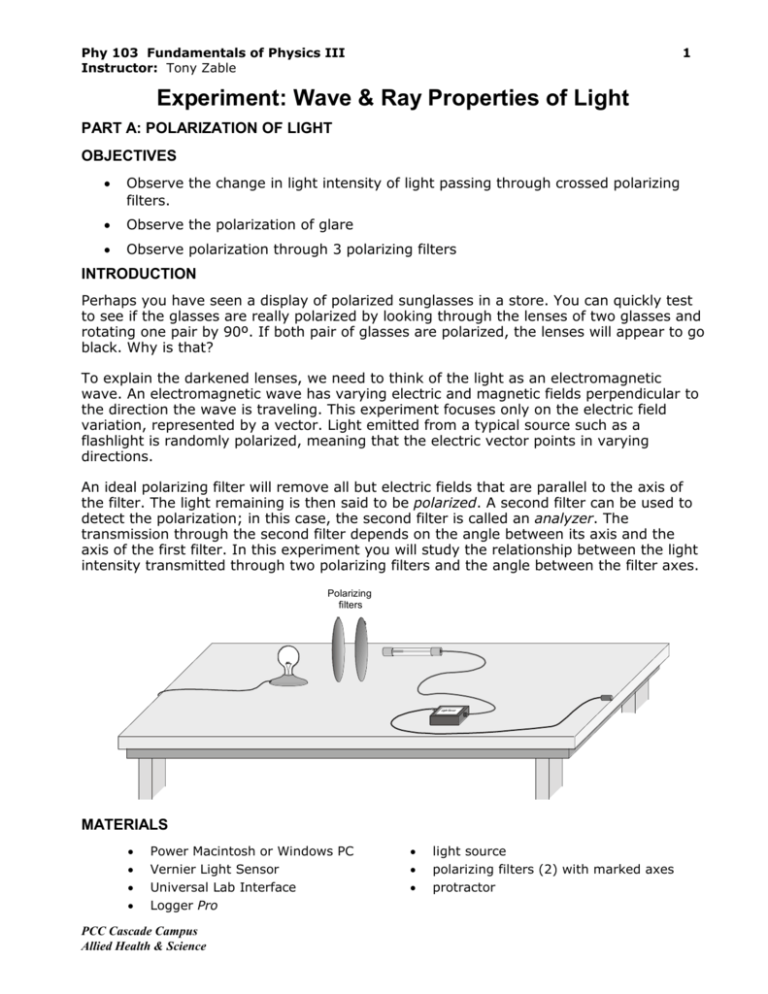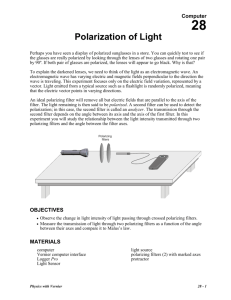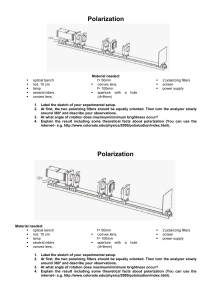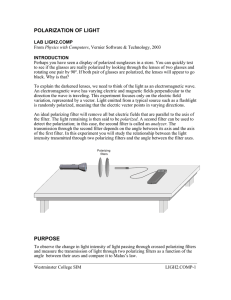Ph103_Lab10_Polarization&Lenses
advertisement

Phy 103 Fundamentals of Physics III Instructor: Tony Zable 1 Experiment: Wave & Ray Properties of Light PART A: POLARIZATION OF LIGHT OBJECTIVES Observe the change in light intensity of light passing through crossed polarizing filters. Observe the polarization of glare Observe polarization through 3 polarizing filters INTRODUCTION Perhaps you have seen a display of polarized sunglasses in a store. You can quickly test to see if the glasses are really polarized by looking through the lenses of two glasses and rotating one pair by 90º. If both pair of glasses are polarized, the lenses will appear to go black. Why is that? To explain the darkened lenses, we need to think of the light as an electromagnetic wave. An electromagnetic wave has varying electric and magnetic fields perpendicular to the direction the wave is traveling. This experiment focuses only on the electric field variation, represented by a vector. Light emitted from a typical source such as a flashlight is randomly polarized, meaning that the electric vector points in varying directions. An ideal polarizing filter will remove all but electric fields that are parallel to the axis of the filter. The light remaining is then said to be polarized. A second filter can be used to detect the polarization; in this case, the second filter is called an analyzer. The transmission through the second filter depends on the angle between its axis and the axis of the first filter. In this experiment you will study the relationship between the light intensity transmitted through two polarizing filters and the angle between the filter axes. Polarizing filters MATERIALS Power Macintosh or Windows PC Vernier Light Sensor Universal Lab Interface Logger Pro PCC Cascade Campus Allied Health & Science light source polarizing filters (2) with marked axes protractor Phy 103 Fundamentals of Physics III Instructor: Tony Zable 2 PRELIMINARY QUESTIONS 1. Place one polarizing filter on top of a second so you have to look through both of them. Rotate the top filter until the axis marks are at right angles to one another. What do you notice? 2. Rotate a filter so the axes are now parallel. Look through the stack and rotate the top filter about your viewing axis by 180º. Make a qualitative graph of the transmitted light intensity you observed as a function of the angle. PROCEDURES 1. Place the light source, polarizing filters, and Light Sensor so light passes through the filters and then into the sensor. You will rotate only one filter to change the transmission; the other filter, the light source, and the sensor must not move. Turn on the light source. 2. Connect the Light Sensor to the Universal Lab Interface. Set the switch on the Light Sensor box to the 600-lux range. 3. Open the file “Exp 31” from the Physics with Computers experiment files of Logger Pro. Light intensity is plotted vs. analyzer angle. Data will be collected in Event with Entry mode, meaning that the light intensity will only be measured when the Keep button is clicked. You will then type the analyzer angle in degrees and press ENTER to complete the data point. 4. Rotate the analyzer until the Light Sensor reading is maximized. The Light Sensor reading is shown in the status bar at the bottom of the Logger Pro window. If the reading is larger than 600 lux, reduce the intensity of the light source and rotate the analyzer again for maximum sensor reading. This is your zero angle. The axis marks on the two filters should be parallel. 5. Set the filters so their axes are at right angles. Very little light should get through the pair of filters. Define the light level as zero by clicking . The intensity reading should now be near zero. 6. Return the analyzer to the parallel position. Click to begin data collection. Click Keep to take the first point and enter 0 for the angle. Press ENTER to complete the entry. 7. Rotate the analyzer by 15º, click Keep , and enter 15 for the angle. Repeat this process, entering 30 for the next angle, and so forth, until you have rotated the analyzer through one revolution, or 360º. Click to end data collection. 8. Describe your graph of light intensity vs. angle, giving important patterns and points. PCC Cascade Campus Allied Health & Science Phy 103 Fundamentals of Physics III Instructor: Tony Zable 3 9. Polarized sunglasses selectively remove glare caused by light reflected by horizontal surfaces, e.g., the hood of a car or a wet highway. For polarized sunglasses to be effective, the glare must be polarized. Devise an experiment to measure how strongly polarized the glare is compared to sunlight or to a flashlight. You will need a smooth horizontal surface to create glare, a bright light source, a polarizing filter, and your Light Sensor and interface. 10. Question: How is the axis of the polarizer oriented when the glare is minimized? 11. Set your two filters so that the polarizing axes are at 90º. Add a third polarizing filter between the first two and collect data of the transmitted intensity as a function of the angle of the middle filter. 12. Can you explain the shape of the graph with a vector model. PART B: LENSES AND IMAGE FORMATION Objectives: To determine the focal length for a magnifying glass (converging lens) To compare images formed with a magnifying glass with the lens equation Part 1: The focal length of a magnifying glass Procedure 1. Place a magnifying glass between a piece of white paper and a object bright object (such as the sun, a glass door or a fluorescent light). 2. Adjust the distance of the magnifying glass until the image of the object is focused on the paper. 3. Using a meter stick, measure the distance from the center of the magnifying glass to the focused image on the paper. If the object is much further away from the lens than the image, this distance the approximate focal length of the magnifying glass. Focal Length = _________ (don’t forget the units) Questions: 1. What do you observe about the size of the image formed on the paper? 2. What do you observe about the orientation of the image formed on the paper? PCC Cascade Campus Allied Health & Science Phy 103 Fundamentals of Physics III Instructor: Tony Zable 4 Part 2: Image Formation Procedure 1. Obtain an illuminating object source. 2. Attach the object source to a ring stand. 3. Measure the length of the object (the arrow…) Length of the object = ___________ 4. Place a white screen (or piece of paper), about 2 meters from the object source. Measure and record this distance. Distance from object to screen= ___________ 5. Plug in the light object source and place the magnifying glass between the object and the screen. Position the magnifying glass lens so that an image is focused on the screen. 6. What is the orientation of the image (compared to the object)? 7. Record the distance from the object to the lens and the distance from the image to the lens. Distance from object to lens= o =___________ Distance from image to lens= i =___________ 8. Measure the size (length) of the image. Length of image = ___________ Questions: 1. Write out the lens equation: 2. Can you use your measurements above to verify this equation? If so, do it. If not, ask the instructor for assistance. 3. Determine the magnification of the image. PCC Cascade Campus Allied Health & Science Phy 103 Fundamentals of Physics III Instructor: Tony Zable 5 4. Is the position of the magnifying glass (in the above measurements) the only location where the image is focused on the screen? Check this. (Hint: it shouldn’t be…) Part 3: Image Formation (Revisited) Procedure 1. Locate the other position where a focused image is produced on the screen and measure the distance from lens to object and distance from lens to image. Distance from object to lens= o =___________ Distance from image to lens= i =___________ 2. Measure the size (length) of the image. Length of image = ___________ Questions: 1. How does the image produced in Part 3 compare with the image formed in Part 2? 2. Try to verify the lens equation using your new measurements. 3. Do your measurements in Part 3 compare to those taken in Part 2? If so, how? 4. Determine the magnification of the image. Use your class lecture notes as a reference. 5. How does the magnification in Part 2 compare with the value in Part 3? PCC Cascade Campus Allied Health & Science










